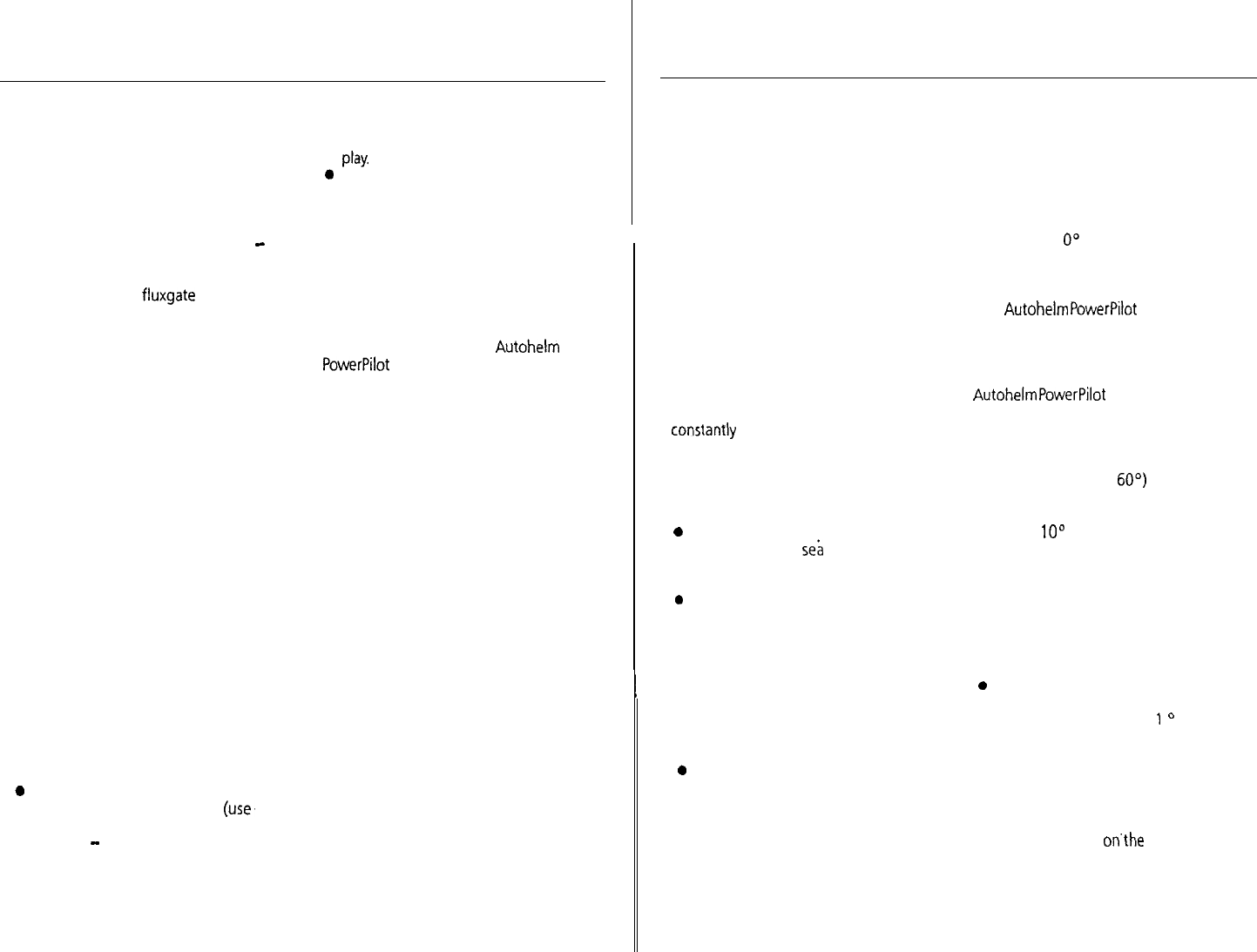
left in this condition the rudder will
eventually be driven hard over. If, however,
the vessel were moving through the
water, the progressive application of
additional helm would eventually return
the vessel to the correct course with the
necessary standing helm applied. Return
to course can be simulated by keying
-
10
(to return to the current heading). The
progressive application of standing helm
will cease when the fluxgate senses that
the course error has been removed.
3.3.3 Drive Unit Test Procedures
Before attempting sea trials it is important
to check that the vital link with the
steering system provided by the hydraulic
pump and rudder reference transducer
are free from obstruction and operating
correctly.
Warning
When the steering system is being moved
manually or under drive from the
autopilot do not touch any part of the
system. The forces exerted are
considerable and could cause injury.
With an assistant to turn the main
steering wheel get into a position where
the tiller and rudder reference transducer
can be seen.
l With the autopilot in Stand by turn
the sheering wheel from hard over to
hard over.
l
Check that the rudder reference
transducer and linkage do not foul any
part of the steering mechanism or
vessel’s structure.
0 Select Auto and use the + 10 button
to drive the rudder hard over (use’
maximum rudder setting).
l Use the
-
10 button to drive the
rudder hard over in the opposite
direction.
22
l
Check that the steering ram moves
smoothly and that there is no excessive
play.
0 Check that all unions are tight and
there is no seepage of hydraulic fluid.
Current Limit and Cutout
When the rudder is driven onto end stops
drive to the hydraulic pump may cut out
after a few seconds. This is normal. Drive
will only be restored if the rudder moves
away from the end stop or if drive is
required in the opposite direction.
The performance of the
Autohelm
PowerPilot will only reach the designed
levels if the installation of the hydraulic
pump and rudder reference transducer is
correctly engineered and adjusted. It is
strongly advised that these be checked
before sea trials.
4. SEA TRIALS
Initial sea trials should be carried out in
calm conditions with plenty of sea room.
The previously conducted functional test
will have verified that the autopilot is
operating correctly and that you are
familiar with all of its controls.
Set the rudder control on all control
units to minimum.
Initial sea trials on fast planing vessels
should be conducted at no more than half
engine speed. Minimum setting of the
rudder control should provide stable
steering performance.
Fine setting of the rudder control is
discussed later (4.2).
4.1 FIRST SEA TRIALS
During first sea trials, the vessel will be
constanfly changing heading, and it is,
therefore, very important to maintain a
constant look-out. The following initial
trial procedure is recommended:-
@ Steer on to a compass heading and
hold the course steady.
0 Press Auto to lock on to the current
heading. In calm
sea
conditions a
perfectly constant heading will be
maintained.
0 Alter course to port or starboard in
multiple increments of 1 and 10
degrees from any control unit. Course
changes should be prompt and
without any sign of overshooting.
l
If a hand held control unit is fitted key
Manual to change over to remote
power steering. Practice power
steering using the four course control
keys..
0 Press Stand by to disengage the
autopilot for return to hand steering.
Automatic Sea State Control
During the sea trial, the operation of the
automatic sea state control can be
observed. When the autopilot is initially
engaged in Auto mode the autopilot will
respond to all pitch and roll movements.
During the first minute of operation, it will
be noticed that repetitive movements of
the vessel are gradually neglected until
finally the autopilot will respond only to
true variations in course.
To ensure precise course adjustments
the sea state control is automatically reset
whenever a 1
O0
course change is
selected.
Automatic Trim Control
The Autohelm
PowerPilot
automatically
corrects for trim. No adjustment of the
pilot is necessary.
After each course change the
Automatic Trim is cancelled and the
Autohelm
PowerPilot
will re-establish the
correct trim for the new heading. This
process takes approximately one second
per degree of course change. It should be
noted that if a large course change is
keyed in (greater than 60°) the pilot will
not assume the final selected course
immediately. The vessel will come to
within say
10”
of the desired course and
will only settle onto course when the
Automatic Trim has been fully established.
It is recommended the following
procedure is adopted for large course
changes.
l
Note required new heading
l
Select Stand by and steer manually
l
Bring vessel onto new heading
0
Select Auto and let vessel settle onto
course
l
Bring to final course with
1
0
increments.
It is sound seamanship to make major
course changes only whilst steering
manually. In this way any obstructions or
other vessels may be cleared properly and
due account taken of the changed wind
and sea conditions on.the new heading
prior to engaging the pilot.
23


















